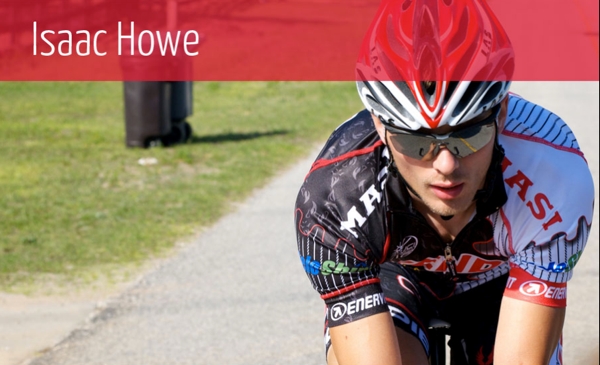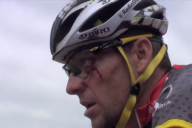Dan Kalbacher (@DanKalbacher) is a blogger, cycling fan, neo-racer, and law enforcement official with a degree in Criminology, Law and Society. He brings a unique understanding of the Isaac Howe case to us in this op/ed piece.
His views are his own and do not necessarily represent his jurisdiction’s positions, strategies, or opinions.
You can read more of his writings by following him on twitter and on his blog.
* * * * *
This past weekend, first on Twitter and then via a news story reported by VeloNews and Cyclingnews.com, we learned of an extremely disturbing incident that occurred at the Electric City Circuit race on May 5th in Anderson, SC during “SpeedWeek,” where it appeared from all reports and accounts that Kenda-5-Hour Energy p/b Geargrinder racer Isaac Howe was intentionally crashed by another rider in the race . Of course there are two sides to every story, and the most recent update from VeloNews contained accused rider Jonathan Atkins’ account of the event. In the near future I am going to provide my own insight into the potential of criminal charges against Atkins for his actions, but for now I will provide as much of an analysis as I can based on conversations with Isaac Howe, from the VeloNews and Cyclingnews reportage, and from other riders’ viewpoints of both riders involved and that race.
While VeloNews has done a great job covering the crash, its aftermath, and some of the events leading up to the “accident,” I want to further explore those events that happened immediately before the incident and immediately after – because for me, it’s very important to examine the events surrounding the incident. A more detailed analysis is necessary to begin to understand if this was truly an accident. Examining the causal incidents can allow us to determine if Jonathan Atkins’ claims are either supported or debunked by witness testimony and a close reading of the helmet-cam video of the minutes leading up to the crash.
The first instance to examine is during the race when Atkins states he believed he was being purposely ridden off the road by Howe and eventually caught up to him and demanded an apology. Atkins did not get the apology he wanted – even after allegedly threatening Howe – which more than likely further angered Atkins, who felt he was deliberately ridden off the road. Howe told me that when Atkins went off into the grassy field at the beginning of the chain of events, it was due to Atkins’ attempt to ride too closely to the right-hand gutter side of the road, and he simply ran out of room. When an apology was demanded of him, Howe thought it odd that Atkins believed he was purposely ridden off the road, given how significantly smaller a rider Howe is compared to Atkins. When I questioned Howe about him allegedly “making fun” of Atkins, he said that in that earlier interview he miscommunicated when referring to his response as “making fun of Atkins,” when it was more along the lines of pointing out the hilarity that a smaller rider could force the larger one into going off the road. I pointedly asked Howe, and he told me that he never made fun of Atkins directly and he was forthright when he said so. Howe simply told Atkins he wasn’t the reason he went off the road, and eventually ignored him and continued focusing on his race at hand.
Recently, a YouTube helmet cam video provided an opportunity to replay the race, and although it was inconclusive as to who was at fault during the crash, some things just don’t add up about the crash. In addition to viewing the YouTube clip, I also had the opportunity to interview Isaac and attempt to piece everything together. First, after watching a few laps of the race it did not appear to be anything extra crazy from what usually happens in bike races, even at the professional level. Going into the turn, both Howe and Atkins easily cleared the corner and were well into the straightaway when Howe went down. The rider with the camera was very well behind and was in a sprint to catch back up before avoiding the crash. When reviewing the video, I cannot understand how, if both riders were holding their line in the straightaway, that they would have crashed. Atkins’ explanation about it does not validate his story about an accident, because the crash occurred well after the turn and there did not appear to be a long line of crash carnage. For the crash to have occurred immediately coming out of the corner, Howe would have had to have skidded at least 100-150 feet to end up in the position he was in once the helmet cam passed him.
In asking Howe about Atkins’ two lines into the turn and one coming out theory, Howe again reiterated the conclusion I came to after watching the video; it doesn’t add up. Howe remembered that going into the turn prior to the crash, there were more than two lines going in and more than one coming out. He did note, and the video does show, that eventually they went to one line at the front – owing to the crosswinds that were occurring – but again, that was significantly past the turn and much further down from where Howe crashed. At the time of the crash, Howe stated that there was a rider on his right hand side coming out of the turn and they were already in the straightaway. It was at this time that Howe remembered feeling a hand grab his left elbow and eventually his own hand going underneath the handle bar, resulting in him going essentially head and shoulder first into the pavement. Howe’s account, he’d told me, has been corroborated by numerous witnesses who were riding behind him at the time of the crash.
If we turn to the YouTube helmet cam footage, starting at 10:00 minutes into the video you will see that the cam is way in the back of the pack, but it shows that riders were comfortable to be riding three and four abreast going into the turn. At 10:06, if you look towards the front you will see that riders are still riding two and three across coming out of the turn going into the straightaway. Also, if you freeze the video at 10:06 you will notice that Howe’s account is corroborated, as we see riders going into the turn two and three abreast with complete ease and significant room between them. If you freeze at 10:10 you will notice that coming out of the turn you will see at least two riders riding abreast. In breaking down these moments immediately before the crash, nothing Atkins claimed to have happened is corroborated by the video. Again, while this video cam footage did not show Howe and Atkins, if everything is taken into account with the limited video we have, it appears that the two lines in, one line out theory just does not add up as the reason for Atkins’ accidental crash story.
It is also important to note the nature of the injuries in this crash analysis. First, Howe suffered multiple fractures of his collarbone which are indicative of a serious crash. However, more telling to me is the fact that Howe said that his helmet “exploded” from the impact when he went over his bike and landed. Atkins’ explanation that the crash was the result of coming out of the turn is not borne out in Howe’s injuries because if it was coming out of a left hand turn and from the position where Howe lay on the pavement, he would have had to have skidded at least 125 yards to be in that position. According to Howe, there were no road rash wounds on the left side of his lower body – wounds which would have occurred if he’d skidded out on a left hand turn. The extent of visible and apparent injuries on Howe’s body on the left side of his head, shoulder and elbow, again, are very indicative of going over a bike head first after having the left hand pulled underneath the handle bar. Howe also reiterated to me that he was riding straight at the time since they were significantly beyond the turn and he had a rider on his right-hand side when Atkins’ came up behind him on his left and pulled his left arm down.
Howe alleges that Atkins took him down intentionally. While the YouTube clip does not prove what happened, we have to ask what incentive does Howe have to lie about this and specifically to single out Atkins? More specifically, the YouTube helmet cam does not validate that “turn one” – the left-hander which Atkins described – was causing any difficulty for the riders who had navigated it prior the crash. If, according to Atkins there were two lines going in and one coming out, then where the two lines became one is where the crash would have occurred, and at a point much earlier than where it actually did. Also, it is important to note that Howe stated he had one of his “bigger riders” come back to protect him from Atkins’ behavior. Once Atkins came back to to Howe after riding off into the grass field, Atkins was riding in a manner Howe felt was to intimidate him and essentially coerce him into an apology. Atkins rode in front of Howe and was looking back at him while riding in the peloton, essentially disregarding riders in front of him. There appears to be no reason for doing that other than to prove a point, or as Howe believes, to intimidate him into an apology. It further reiterates that once Atkins went off the road after what appears to be because of his own riding and no one else’s behavior, his actions were focused less on the bike race and more on simply getting revenge for the perceived slight.
In talking to Howe about the race and the events that transpired, Howe told me that he noticed the tension building in the races leading up to Electric City. He also noted that even though he is a professional racer, he can definitely empathize with the amateurs who race alongside him. In fact, Howe indicated that he relates more to them than to the professionals, as he spent 11 years racing as an amateur before turning pro. Howe knows that it’s important to say something in a race if it makes things safer for everyone involved. He told me that “me taking the responsibility is not because I am a professional, but rather a concerned rider who races every weekend. Being a professional does not make me feel entitled to tell people what to do, but because this is my job I have a lot more at stake than many people.” Howe makes his living this way and this injury has put him – and more importantly, his team – in a financial situation they were not anticipating. In going into Electric City, Howe was more than likely going to move into the top ranking in the country, which in turn would have brought in more sponsor money for his team. That is now lost opportunity due to sequence of events that brought down Howe.
In the coming days I’ll be writing another piece exploring the aspect of bringing criminal charges against Atkins, and why they may be necessary not only in the interest of justice for Isaac Howe and Team Kenda 5-Hour-Energy Systems, but also as a deterrent to protect riders in the future and ensure this does not happen again. In looking at the facts I’ve presented and reviewed above, I can’t logically piece together Atkins’ theory and explanation of how the events described could possibly have transpired according to his account. Hopefully, the investigations that are ongoing with USA Cycling and the legal system will eventually get everyone the answers that need to be found to ensure something like this does not happen again.















1 Comment
[…] City Circuit race because inital reports indicated that it was an intentionally-caused crash. Earlier this week I took the opportunity to review information provided by several eyewitnesses as well as a video […]